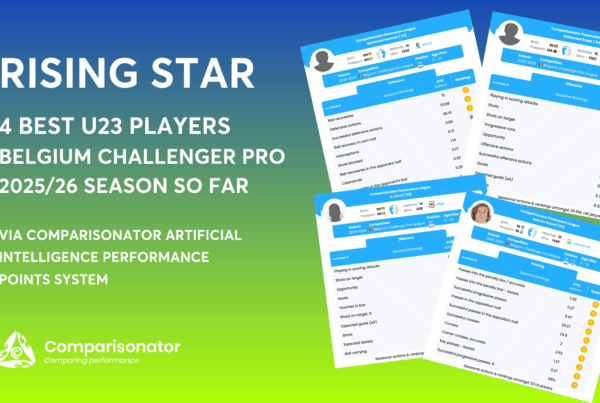Expected Goals (xG) is a statistical metric used in football to assess the quality of goal-scoring opportunities. It calculates the likelihood of a shot resulting in a goal by analyzing various factors such as shot distance, angle, and the type of assist leading to the shot. Each shot is assigned an xG value between 0 and 1, indicating the probability of scoring; for example, a shot with an xG of 0.2 suggests a 20% chance of resulting in a goal. This metric provides deeper insights into a team’s or player’s performance beyond traditional statistics, helping to evaluate the effectiveness of offensive plays and decision-making.
Comparisonator football data analysis platform is an AI-driven football analytics platform designed to compare players, teams, and leagues using advanced statistical metrics. It delivers detailed performance evaluations by leveraging data-driven insights, AI-powered algorithms, and GPT models, helping clubs, scouts, analysts, and agents make informed decisions.
What sets Comparisonator player recruitment and scouting platform apart from traditional data platforms is its ability to normalize data across different leagues. This means that a goal scored in the English Premier League is weighted more than one in a lower-tier league, ensuring fair and accurate comparisons of player performances across competitions. With its AI-enhanced evaluation system, Comparisonator recruitment platform serves as a powerful tool for football professionals seeking objective and data-backed insights.
Understanding Expected Goals (xG) in Football
Expected Goals (xG) is a key statistical metric used in football to measure the quality of goal-scoring opportunities. Unlike traditional statistics such as goals and assists, xG provides a deeper analytical perspective on a team’s or player’s attacking efficiency. It calculates the probability of a shot resulting in a goal by considering multiple critical factors, such as shot distance, angle, assist type, and defensive pressure.
Each shot is assigned an xG value between 0 and 1, indicating the likelihood of scoring. For example, a tap-in from close range with no goalkeeper in front might have an xG of 0.9 (90%), meaning it is highly likely to be a goal. Conversely, a long-range effort from 30 yards out could have an xG of 0.05 (5%), reflecting a very low probability of scoring. Similarly, a penalty kick typically carries an xG value of 0.78 (78%), since penalties are statistically converted at a high rate. Comparisonator scouting platform ranks and compare players in more than 300 parameters including xG.
How xG is Calculated
To determine the xG of a shot, analysts use data from thousands of past goal-scoring attempts to identify patterns in finishing success. Key elements considered in xG calculation include:

- Shot Location: The closer the shot is to the goal, the higher the xG value.
- Shot Angle: A shot taken from a central position has a higher chance of scoring compared to a tight-angle attempt from the wing.
- Shot Type: A powerful volley or header typically has a lower xG than a simple tap-in.
- Defensive Pressure: If a player is under pressure from multiple defenders, their xG value decreases due to reduced accuracy.
- Goalkeeper Positioning: A well-positioned goalkeeper makes it harder to score, lowering the shot’s xG value.
- Pass Type (Assist): A shot created from a well-placed through ball has a higher xG than one from a contested cross.
Why xG is Important in Football Analysis
The Expected Goals metric allows analysts, coaches, and fans to evaluate a player’s performance beyond the number of goals scored. For instance, a striker who has scored 10 goals with an xG of 5 might be overperforming, meaning they are finishing chances better than expected. On the other hand, a striker with 10 goals but an xG of 12 might be underperforming, indicating they have missed several high-quality opportunities.
Comparisonator recruitment platform compares player in 271 leagues to filter and understand the suitability to teams.
According to Comparisonator football data platform, Kodjo Fo Doh Laba (’92) from Al Ain in the UAE Arabian Gulf League leads the ranking for expected goals (xG) per 90 minutes, registering an impressive 1.25 xG per match this season in 271 leagues. Following closely is Cherif Ndiaye (’96) from Crvena Zvezda in Serbia’s Super Liga, with an xG of 1.12, while Ragnar Ache (’98) from Kaiserslautern in Germany’s 2. Bundesliga records 0.97 xG per 90 minutes.
Dean David (’96) from Maccabi Haifa in Israel’s Ligat ha’Al follows with an xG of 0.93, just ahead of Harry Kane (’93) from Bayern München in Germany’s Bundesliga, who records 0.92 xG per match. Mateo Retegui (’99) from Atalanta in Italy’s Serie A registers an xG of 0.90, while Viktor Gyökeres (’98) from Sporting CP in Portugal’s Primeira Liga records 0.89 xG per match. Comparisonator football data analysis platform reveals that Daniel Kasper (’02) from Greuther Fürth II in Germany’s Regionalliga follows with 0.87 xG per 90 minutes, while Robert Lewandowski (’88) from Barcelona in Spain’s LaLiga records 0.82 xG per match. Rounding out the top ten is Gustaf Nilsson (’97) from Club Brugge in Belgium’s First Division A, who achieves 0.81 xG per 90 minutes. These players consistently find themselves in high-quality goal-scoring positions, demonstrating strong attacking instincts and positioning in front of goal.

xG From a Team Perspective
From a team perspective, xG helps managers assess offensive efficiency and tactical effectiveness. A team with a high xG but few goals may struggle with finishing, while a team with a low xG but many goals could be benefiting from lucky or exceptional finishing. By analyzing xG trends, coaches can adjust tactics, player selection, and attacking strategies to improve goal conversion rates. Comparisonator soccer analysis platform helps decision-makers to indicate the player performance.
Expected Goals (xG) is a powerful tool in modern football analytics, offering insights into attacking performance, finishing ability, and decision-making. It provides a clearer picture of whether a team or player is creating and converting high-quality chances, making it an essential metric in football evaluation.
Top Expected Goals (xG) Producer Football Players in The Top Five European leagues
Comparisonator football platform search shows the top expected goals (xG) producers in the top five European leagues showcase some of the most elite goal-scoring talents. Harry Kane (’93) from Bayern München in the Bundesliga leads the list with 0.92 xG per 90 minutes, followed closely by Mateo Retegui (’99) from Atalanta in Serie A with 0.90 xG. Robert Lewandowski (’88) from Barcelona in LaLiga records 0.82 xG per match, while Kylian Mbappé (’98) from Real Madrid in LaLiga follows with 0.74 xG. Hugo Ekitiké (’02) from Eintracht Frankfurt in the Bundesliga produces 0.71 xG per 90 minutes, while Erling Haaland (’00) from Manchester City in the Premier League registers 0.68 xG, narrowly ahead of Mohamed Salah (’92) from Liverpool, who has 0.66 xG per match.

Comparisonator player recruitment and scouting platform’s analysis indicates Dušan Vlahović (’00) from Juventus in Serie A records 0.65 xG, just ahead of Nicolas Jackson (’01) from Chelsea in the Premier League, who posts 0.64 xG per 90 minutes. Completing the top ten is Ermedin Demirović (’98) from Stuttgart in the Bundesliga, with 0.62 xG per match. These players consistently create high-quality scoring chances, reflecting their strong attacking positioning and finishing abilities in Europe’s most competitive leagues.
Expected Goals (xG) Explained with Examples
Expected Goals (xG) is a statistical metric used in football to assess the quality of goal-scoring opportunities. It calculates the likelihood of a shot resulting in a goal by analyzing various factors such as shot distance, angle, the type of assist, and whether it was a one-on-one chance or a difficult attempt from outside the box.
Each shot is assigned an xG value between 0 and 1, indicating the probability of scoring. For example:
- A close-range tap-in with an open goal might have an xG of 0.9 (90%), meaning it is highly likely to result in a goal.
- A penalty kick typically has an xG of 0.78 (78%), as penalties are often converted but can still be missed.
- A long-range shot from 30 yards might have an xG of 0.05 (5%), meaning it is a low-probability chance.
- A header from a corner kick could have an xG of 0.15 (15%), depending on positioning and defensive pressure.
This metric provides deeper insights into a team’s or player’s performance beyond traditional statistics, helping to evaluate whether a player is taking high-quality shots or just attempting difficult, low-percentage chances. For instance, a striker with 10 goals but an xG of only 5 might be overperforming and scoring difficult shots, while another striker with 10 goals and an xG of 12 might be missing clear chances and underperforming.
By understanding xG, coaches, analysts, and fans can better judge a player’s finishing ability, offensive decision-making, and overall efficiency in front of goal.
How Comparisonator Artificial Intelligence Utilizes Expected Goals (xG)?
The Comparisonator football data platform is a specialized AI-powered tool designed to function as an expert in football analysis. It has significantly enhanced its Artificial Intelligence Points System, integrating league difficulty and player performance algorithms to provide the most precise player evaluations across different leagues. Now covering 271 leagues worldwide, the platform assigns difficulty and quality weightings to ensure fair comparisons. For example, a goal scored in the English Premier League carries more weight than one scored in the Championship, meaning that 40 goals in the Championship do not equate to 20 goals in the Premier League under this advanced rating system.
As an AI-driven football player sales and marketing platform, Comparisonator offers a more accurate assessment of player levels. The system has further refined its player performance algorithm by implementing position-specific weightings, prioritizing 80-90 key parameters per position from a comprehensive dataset of 300 metrics. Additionally, the platform distinguishes the value of a goal scored by a center forward (CF) compared to one scored by a center back (CB), ensuring a contextualized and precise evaluation of player contributions.
The Top Expected Goals (xG) Producer Soccer Players in South American Leagues
The top expected goals (xG) producers in South American leagues highlight some of the most consistent goal-scoring threats across the continent. Martín Cauteruccio (’87) from Sporting Cristal in Peru’s Primera División leads the rankings with 0.80 xG per 90 minutes, followed by Alex Arce (’95) from LDU Quito in Ecuador’s Liga Pro, who records 0.75 xG per match. Leandro Benegas (’88) from O’Higgins in Chile’s Primera División follows closely with 0.73 xG, while Miguel Borja (’93) from River Plate in Argentina’s Liga Profesional registers 0.69 xG per 90 minutes.

In South American leagues, Comparisonator AI supported football match analysis platform understands Nicolás López (’93) from Nacional in Uruguay’s Primera División posts 0.68 xG, just ahead of Jhon Cifuente (’92) from El Nacional in Ecuador’s Liga Pro, who records 0.62 xG per match. Adrián Martínez (’92) from Racing Club in Argentina’s Liga Profesional also has 0.62 xG, sharing the same mark with Gonzalo Carneiro (’95) from Nacional in Uruguay’s Primera División. José Rivera (’97) from Universitario in Peru’s Primera División follows with 0.61 xG, while Mathías Acuña (’92) from Mushuc Runa in Ecuador’s Liga Pro rounds out the top ten with 0.58 xG per 90 minutes. These players consistently generate high-quality goal-scoring opportunities, demonstrating their importance in their respective teams’ attacking strategies across South America.
How to Understand Expected Goals (xG) in Football
Expected Goals (xG) is a statistical metric that helps assess the quality of goal-scoring chances rather than just counting goals. It measures how likely a shot is to result in a goal based on historical data from thousands of similar attempts. Understanding xG can help fans, analysts, and coaches evaluate player performance, team tactics, and finishing efficiency. Here’s how you can break it down:
1. What Does xG Measure?
xG assigns a probability score between 0 and 1 to every shot taken during a match. This value represents the likelihood of that shot being converted into a goal.
- An xG of 0.1 (10%) means the shot has a 10% chance of scoring.
- An xG of 0.75 (75%) means the shot has a 75% chance of being a goal.
- A perfect chance (like an open goal tap-in) could have an xG close to 1.0 (100%).
2. Factors That Affect xG
xG is not random—it is based on several key factors that influence goal probability:
- Shot Location: The closer the shot is to goal, the higher its xG.
- Example: A shot from the penalty spot (xG = 0.76) is more likely to score than a shot from outside the box (xG = 0.05).
- Shot Angle: The wider the angle, the harder it is to score.
- Example: A shot from the center of the goal (xG = 0.6) has a much better chance than a tight-angle shot near the corner flag (xG = 0.02).
- Type of Shot: Headers, volleys, and first-time shots have lower xG than simple finishes.
- Example: A header from a corner kick (xG = 0.15) is harder to score than a low pass across the goal for a tap-in (xG = 0.85).
- Defensive Pressure: Shots taken under pressure from defenders or when a goalkeeper is well-positioned have lower xG.
- Assists and Build-Up Play: A shot following a precise through ball has higher xG than a random long-range attempt.
3. How xG Helps in Football Analysis
- Evaluating Players: A striker with 10 goals from an xG of 5 is overperforming, while another with 5 goals from an xG of 10 is underperforming and missing good chances.
- Assessing Teams: A team with low xG but many goals might be over-reliant on lucky finishes, while a team with high xG but few goals struggles with finishing.
- Comparing Performance: xG allows fair comparisons between teams and players by focusing on chance quality rather than just the final score.
4. Example of xG in a Match
Imagine a team takes 10 shots in a game:
- 4 long-range shots (xG = 0.05 each) → 0.20 total xG
- 3 penalty box shots (xG = 0.4 each) → 1.20 total xG
- 2 one-on-one chances (xG = 0.7 each) → 1.40 total xG
- 1 penalty (xG = 0.78) → 0.78 total xG
Total xG = 3.58 → This means the team was expected to score around 3-4 goals based on shot quality.
5. Why xG Matters
xG is a powerful tool that helps explain performance beyond traditional stats like goals and assists. It shows whether a team creates quality chances, if a striker is finishing well, or if a goalkeeper is outperforming expectations. By using xG, analysts and fans gain a deeper understanding of a game’s true dynamics rather than just looking at the final score. Comparisonator ai supported football platform helps to define player performance in more than 300 parameters.





